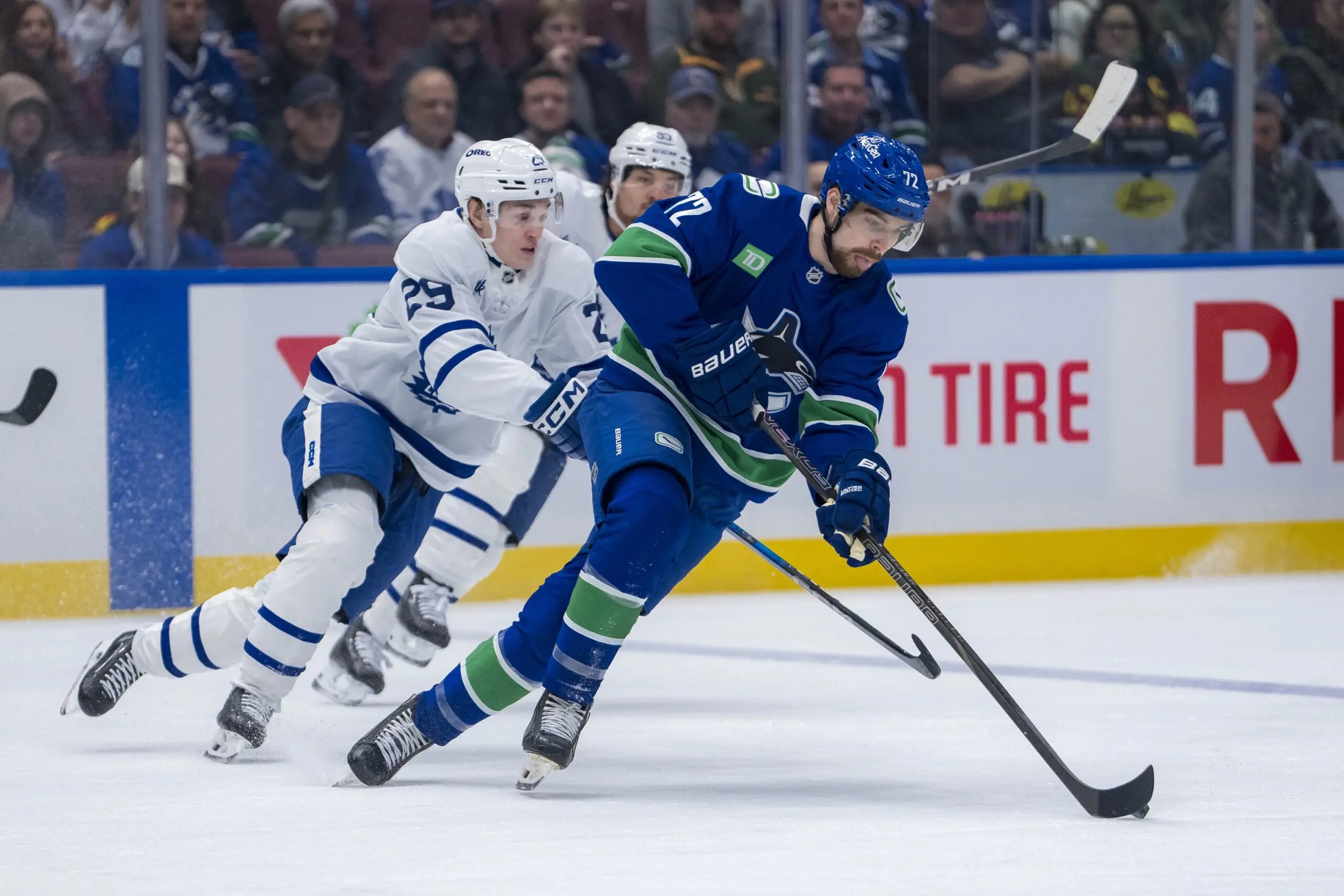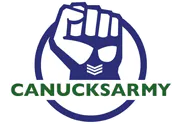Nation Sites
The Nation Network
CanucksArmy has no direct affiliation to the Vancouver Canucks, Canucks Sports & Entertainment, NHL, or NHLPA
February cap space update: How much do the Canucks have to spend at next month’s Trade Deadline?

Photo credit: © Bob Frid-Imagn Images
Feb 13, 2025, 17:02 ESTUpdated: Feb 18, 2025, 12:28 EST
The Vancouver Canucks aren’t finished yet, not in any sense of the word. But they are on a pause.
Mid-February is normally the time of year at which point the entire league would take a wee break for whatever All-Star Game festivities happened to be scheduled for that season. But the 2024/25 break will be a little different. This year, the NHL is stopping all regular season games for two weeks, and in that time the 4 Nations Face-Off will be held.
That means Elias Pettersson, Kevin Lankinen, and Rick Tocchet will be in action, and everyone else on the Canucks will be taking a little rest and relaxation.
Whether that includes the Vancouver front office or not remains to be seen. Though there is not any official roster freeze, it’s generally been considered an unwritten rule that players not be traded during the All-Star Break. Does that same grace period extend to the entire two-week span of this tournament? Only time will tell.
But there is a good chance that the Canucks’ own roster is settled, at least for the next bunch of days. This makes this the perfect time to take a look at the team’s all-new, all-different salary books and provide you with an update on where the Canucks’ cap space is at as of mid-February – and, more importantly, what they’ll have left to spend at next month’s Trade Deadline.
First, how cap space actually works
Before we get to the actual facts, we’ve got to take care of a quick misconception.
The key point to remember here is that although so-called ‘cap hits’ are almost always reported as the annual average value of a player’s contract (or AAV), actual cap hits are calculated on a daily basis.
That means that just adding up the ‘cap hits’ of all the players on a roster and subtracting that from the cap ceiling ($88 million this year) will not give you a team’s cap space. It’s a fine estimate for the offseason, sure, but as soon as games actually start being played, such whole-number concepts go right out the window.
Want proof of that? If you were to add up the AAVs of all the players on the Canucks (currently-reduced) roster, plus their various buyout and retention penalties, you’d come up with a total of $80,396,842.
That should put the Canucks at exactly $7,603,158 below the cap ceiling and, thus, at that same amount of cap space.
And yet…that’s not quite right.
The $88 million ceiling is actually the total amount a team can spend on the entire season’s worth of expenditures. But there are 192 official days on the NHL’s 2024/25 calendar. And a team’s cap hit is counted on each and every one of those days, based on who is actually on the roster each day.
The real cap ceiling, then, is that of a ‘projected cap.’ In short, a team can never form a roster that would eventually project to cost them more than $88 million over the course of the full season (LTIR shenanigans aside).
But a team can certainly put together a roster that projects to cost them less than $88 million over a full season. And that’s where accrual comes in. In fact, ‘accrual’ is probably the wrong word for it because it’s really just basic conservation. The less a team spends each day, the more room they have between them and that ultimate $88 million total.
This leads to projected cap space.
Projected Cap Space: $3,558,722
When one heads over to PuckPedia, the first cap-related number they’ll see listed for the Canucks is that of their projected cap space, which is currently at $3,558,722.
This number is actually pretty easy to conceptualize. It’s this:
On top of what they have already spent, this is the total that the Canucks will spend if they maintain this same exact roster from now until the end of the year.
Now, unfortunately, that number is a little useless at this point in the season. For one, the Canucks won’t be keeping this exact same roster. Prior to the break, they sent down all of Victor Mancini, Linus Karlsson, Nils Åman, and the younger Elias Pettersson, reducing their roster to just 11 forwards, seven defenders, and two goalies.
Obviously, the Canucks will be calling up a few of these players as soon as the break is over, and that will change their projected cap hit.
But that’s okay because, as we said, it doesn’t really matter.
A projected cap space of $3,558,722, or whatever lesser number remains after the call-ups, does not mean the Canucks can add $3,558,722 worth of salary to their roster. Not even close!
The good news is that the amount is actually higher than that.
Current Cap Space: $10,198,129
Now, we’re getting into the numbers that actually matter. Unfortunately, we have to throw another mind-bending wrinkle into the mix.
So, when a team adds a player to their roster, one might think they’ve got to fit their whole cap hit/AAV under the cap ceiling. But that’s not quite right.
Player cap hits are, again, calculated daily. So the amount a team needs to fit in is actually (AAV/number of days remaining on the schedule).
So, the later into the season a player is added, the less of their cap hit needs to be added to the books. And if the team in question has already ‘accrued’ a decent amount of space (or, more accurately, left a decent amount of space between them and the ceiling), then the combination of that extra space and the reduced expenditure for the added players can really multiply into some serious functional spending room.
That’s why the Canucks’ current cap space reads as $10,198,129. That’s the amount of AAV they can add to their roster right now without going over the projected cap limit.
Again, this is counterintuitive. Even with a reduced roster, the Canucks’ current AAVs add up to $80,396,842. By the way we’ve been taught to think about cap space all these years, that should mean the Canucks could only add contracts adding up to $7,603,158 to their roster.
But that’s just not the way it works.
And the best news of all is that it should only get better from here because…
Deadline Cap Space: $16,268,444
The Trade Deadline is the point at which adding new contracts is at its cheapest. This makes sense: it’s the last day to add players to rosters and, thus, the point at which there will be the fewest days left on their contracts.
By our rough count, there are approximately 40 days between the Trade Deadline and the end of the regular season. So, whatever annual cap hit a player has can essentially be divided by 40, and that’s the amount that a team will have to squeeze in between their current amount of expenditure and that $88 million limit.
For the Canucks, that number is currently at $16,268,444. Which is a lot. Keep in mind that the inevitable call-ups will cut into this amount…but not by that much, as each carries a sub-$1 million AAV.
What this really means is that the Canucks could add any one player in the NHL to their roster with no issues – or, more likely, multiple players who add up to that amount of (a bit less than) $16,268,444.
In other words, when it comes to deadline spending space, the Canucks have plenty.
Looking ahead to 2025/26
The nice thing is, once we get back into offseason mode, we can go back to whole numbers and annual cap hits. It’s all theoretical at that point.
Currently, the Canucks have a total of about $73,366,667 committed to their 2025/26 books. The cap ceiling, meanwhile, is jumping all the way up to $95,500,000, which gives the Canucks a current offseason cap projection of a whopping $22,133,333.
That only covers 14 players, however, so said cap space will start disappearing quickly as the roster is built. But don’t worry, as we’ve shown in this article, cap space can come back around, too – especially around Trade Deadline Day.
PRESENTED BY PACIFIC TOYOTA DEALERS

This article is a presentation of Pacific Toyota Dealers who want to send one lucky winner and a friend to check out the Canucks and Golden Knights in the Konica Minolta Champions Club at Rogers Arena on April 6th. The winner will also get 2 Canucks jerseys! Retail value of the grand prize is $1200.00 CDN. To enter, click this link https://bit.ly/4jG6xNj.
Must be a resident of BC and the Yukon of age of majority. Visit ShopToyota.ca today and check out the 2025 BZ4X! Plug In, Power Up and Drive On!
Breaking News
- Quinn Hughes talks thought process in lead-up and aftermath of trade from Canucks to Wild
- Wagner’s Weekly: After Hughes trade, which Canuck will get traded next?
- The Stanchies: Zeev Buium’s two point debut leads the way in Canucks’ 2-1 victory over Devils
- Canucks forward Lukas Reichel clears waivers
- Instant Reaction: Zeev Buium scores game-winning goal in Canucks debut vs. Devils
